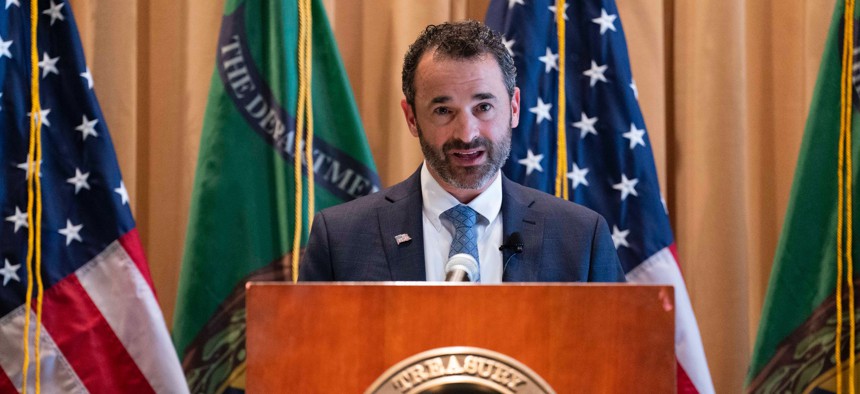IRS outlines tech modernization, CX plans as part of $80 billion overhaul

IRS commissioner Danny Werfel outlined a multi-billion-dollar plan Thursday to modernize agency technology, leverage data analytics and improve customer service. Bonnie Cash / Getty Images
IRS Commissioner Danny Werfel told reporters on Thursday that technology will be key to achieving the agency’s intentions to transform customer service at the agency and shrink the tax gap.
Technology improvements will be foundational to the IRS’ plans to use long-term funding to “transform” the tax agency, IRS commissioner Danny Werfel said in a call with reporters about its plan for how it will spend the nearly $80 billion from the Inflation Reduction Act passed last year.
The IRS wants to become a “world class customer service operation” with digital tools and modern platforms, the plan states, and to use the funding boost to fix staffing and capacity pain points the agency says come from years of underfunding by Congress.
The agency also wants to use data and analytics to inform its auditing and compliance efforts as it looks to shrink the amount of unpaid taxes by the most wealthy Americans and corporations.
“The plan released today is a bold look at what the future can look like for taxpayers and the IRS,” said Werfel. “Now that we have long-term funding, the IRS has an opportunity to transform our operations.
“Underpinning everything,” he added, “is technology.”
The strategic operating plan – released Thursday, over a month after its February due date set by Treasury Secretary Janet Yellen – has more than 190 discrete projects and over 200 specific milestones, Werfel said.
Among them are a number of initiatives aimed at improving services, like addressing wait times for IRS phone lines and the processing of paper tax returns, both of which suffered during the pandemic, although the agency says they have already improved since it got IRA funding.
Also featured are digital services for taxpayers.
“In the first five years of the 10-year plan, taxpayers will be able to securely file documents and respond to notices online and securely access and download their data and account history,” said Wally Adeyemo, deputy secretary at the Treasury Department.
The tax agency intends to improve online accounts with features like updated status tracking tools to get updates on refund and return processing, said Adeyemo.
The IRS also plans to develop capabilities to “help taxpayers identify potential mistakes before filing, quickly fix errors that could delay their refunds and more easily claim credits and deductions they may be eligible for,” he said.
The IRS also wants to rid itself of paper backlogs. It aims to eliminate paper backdogs by digitizing any paper forms and returns when it gets them and moving to “fully digital correspondence processes,” said Adeyemo.
Already, the IRS debuted a tool in February where taxpayers can submit certain requested documentation to the IRS online instead of mailing it, said Adeyemo.
Another potential development is a “free, public electronic return-filing service option” run by the IRS. The agency is studying the feasibility of such a system now, as required by the law. The study is due in May.
Another focus is the IRS’ core technology infrastructure.
One goal is retiring outdated parts of core IRS tax systems and databases, some of which date back to the 1960’s, with the rare, long-term funding provided under the law, said Adeyemo.
“The IRS is a patchwork of systems that today uses decades-old code and case management systems that don't interact with each other,” said Werfel, who called out data security.
“There have been so many rapid changes involving data in recent years that the IRS must play catch up,” he said. “Taxpayer data is being held in old technology at the IRS. We need to invest in newer, modern technology to keep information safe for taxpayers, businesses and others. With long term funding, the IRS can address this.”
The new roadmap also includes details on how it plans to divy up the investment among different priorities.
Business systems modernization will get an estimated $4.8 billion, $3.2 billion for taxpayer services and $25.3 billion for operations support, although the plan notes that might not cover all of the costs associated with the customer service and tech modernization goals.
“We believe that we will need an ongoing investment on top of the allocated IRA funding to deliver all of the transformation objectives outlined in this plan in taxpayer service improvements and information technology modernization,” the plan states, noting that Congress zeroed out appropriations for the business systems modernization account in fiscal 2023 appropriations.
The roadmap also has a plea from Werfel for Congress not to shortchange IRS annual funding with the assumption that the agency can dip into the Inflation Reduction Act funding to cover the difference.
“Any reduction in annual discretionary funds… will require IRA funding to be shifted to general operations… to the detriment of the service, technology and compliance initiatives envisioned to transform the IRS,” wrote Werfel.






